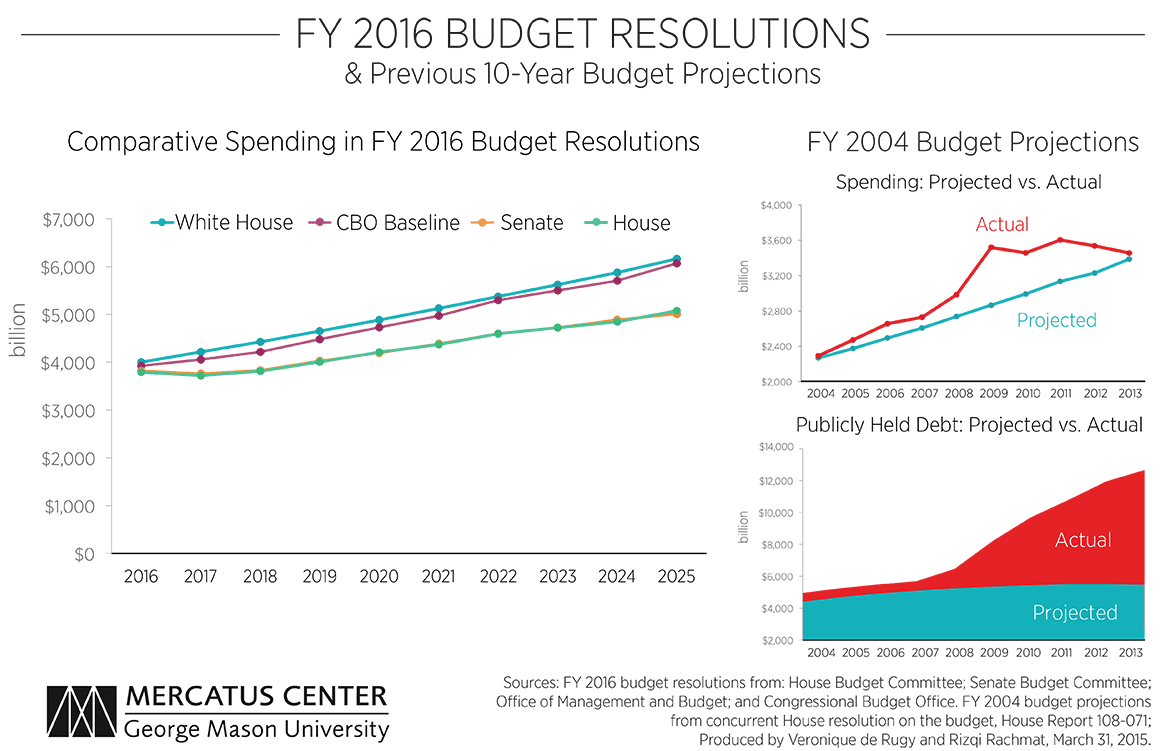- | Government Spending Government Spending
- | Data Visualizations Data Visualizations
- |
Republican Budget Resolutions: Slower Spending but Future Never Certain
This week’s main chart shows that both proposals would reduce the growth in spending versus the Congressional Budget Office’s baseline. On the House side, spending would go from $3.8 trillion in fiscal year 2016 to $5.1 trillion in fiscal year 2025 for a total of $43 trillion over ten years.
The Republican-controlled House and Senate have passed respective budget resolutions for the upcoming 2016 fiscal year. The two chambers are now in the process of trying to reconcile the differences in the hopes of producing a unified budget blueprint to guide Congress’s policy agenda going forward.
This week’s main chart shows that both proposals would reduce the growth in spending versus the Congressional Budget Office’s baseline. On the House side, spending would go from $3.8 trillion in fiscal year 2016 to $5.1 trillion in fiscal year 2025 for a total of $43 trillion over ten years. The Senate’s figures are virtually identical to the House’s proposal. Both proposals claim to lead to a balanced budget by the end of the 10-year horizon. They also project to spend considerably less than what the Obama administration wants—a combined $7 trillion less over 10 years. The administration also wants to increase taxes while the Republican proposals eschew tax increases.
The Republican plans, however, employ budget “gimmicks” that undermine the promise to eventually bring the federal government’s finances into balance. For example, both plans would eliminate Obamacare spending but would keep Obamacare levels of revenue. They also assume that Congress will not extend “temporary” tax breaks (“tax extenders”) even though, when the time comes, Congress will almost surely extend them.
The most glaring issue is that while the Republican proposals would keep the Budget Control Act’s spending caps in place, they would immediately seek to get around them by allocating $96 billion in defense funds to the Overseas Contingency Operations (OCO) account. The OCO, which isn’t subject to the caps, was originally created to pay for the wars in the Middle East but has since become a “slush fund” to work around limits on defense spending.
The upfront jump in defense spending is a perfect example of why the 10-year budget projections contained in these proposals are of limited value. Indeed, it is a routine practice of policymakers to call for increases in spending now in exchange for promises to reduce spending in the future. So long as the federal government remains largely unrestrained in its ability to spend money on almost anything that policymakers’ desire, the odds are that they will eventually find an excuse to spend money beyond what was originally projected.
The last time that a Republican Congress came to an agreement on a budget resolution containing a 10-year horizon is illustrative. The first inset chart shows projected spending under the 2004 budget resolution versus what actually happened. Regardless of the change in circumstances that led to the divergence, the bottom line is that the federal government ended up spending a combined $2.6 trillion extra over the 10-year time frame.
The second inset chart shows projected debt held by the public under the 2004 budget resolution versus what actually happened. Instead of publicly held debt of $5.4 trillion in fiscal year 2013, the actual figure ended up being almost $12 trillion. Again, the circumstances changed (e.g., the wars in the Middle East didn’t go as planned, the deep recession hindered federal revenues, and Democrats later attempted to revive the economy with massive spending), but the fundamental point is the same: promises to limit the future size of the federal government (in terms of spending) will remain tenuous so long as the scope of the federal government’s activities remain practically unlimited.
While it is true that the Republican proposals would attempt structural changes to major programs like Medicaid, the reality is that neither proposal seeks to end any of the federal government’s seemingly countless roles and responsibilities. Without a change in what federal government is expected to do, it will remain difficult for lawmakers to control the growth in spending and debt.


